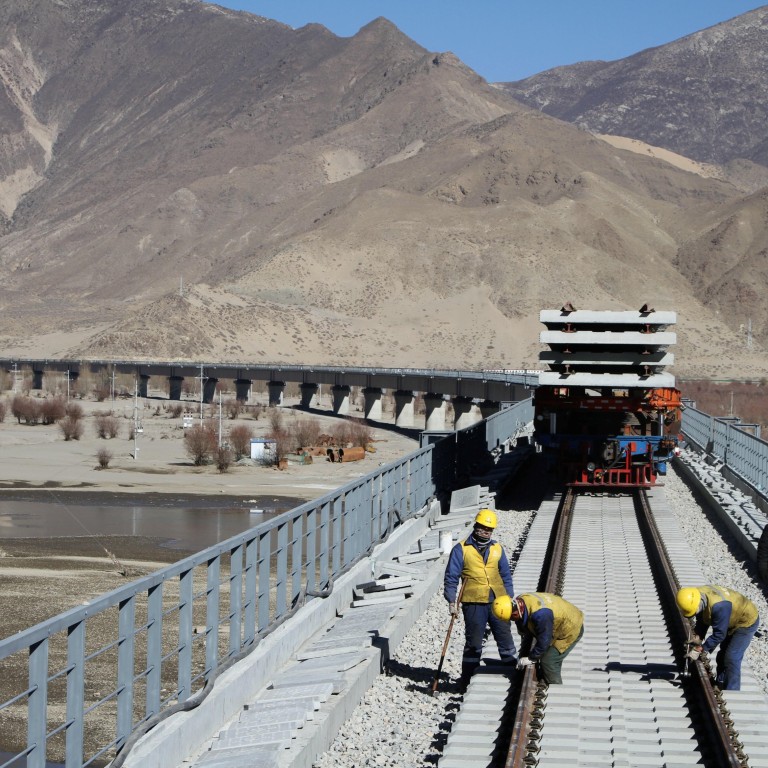
Full speed ahead for China’s high-speed rail network in 2019 in bid to boost slowing economy
- The state-owned China Railway Corporation plans to put a total of 6,800km of new track into service this year, a 45 per cent increase in expansion from 2018
- Significant infrastructure investment by a Beijing government keen to offset the trade war with the United States
China plans to expand its high-speed rail network by 3,200km in 2019, which is more than is currently being operated in either Spain, Japan, Germany or France, in a bid to aid a slowing economy locked in the trade war with the United States.
The China Railway Corporation, the state-owned agency in charge of railway construction, plans to put a total of 6,800km of new track into service in 2019 as Beijing again relies on infrastructure investment to arrest an economic slowdown, according to a government plan released this week.
Spain, which has the world’s second biggest high-speed rail network after China, only has a total of around 3,100km of track in operation, followed by Japan, Germany and France.
China’s spending spree on railway infrastructure, which started in the aftermath of the global financial crisis a decade ago, means Beijing is well ahead of its schedule to build a total of 30,000km of high-speed railway lines by 2020.
At the end of 2018, China had over 29,000km of 250km/h (155mph) high-speed railway lines, two thirds of the world’s total, having added 4,100km in 2018 as part of a 4,683km overall expansion project last year.
As China is completing its strategic goal of building a nationwide high-speed rail network after a decade of construction, which has greatly reduced travel time between major Chinese cities, the railway authority is now looking at new lines that extend deep into the country’s remote corners.
These include a second railway from Sichuan to Tibet – a line that is strategically important but also has to cross some of the deepest valleys in the world along the route.
China Railway said a feasibility study of the 1,700km line winding through the “roof of the world”, with a budget of 250 billion yuan (US$36.42 billion), is scheduled to be completed in the second quarter before before a possible start to construction in the third quarter. The project is not included in the 6,800km total for 2019.
Beijing’s determination to invest in railway infrastructure came after the country’s fixed asset investment, a major growth engine, slowed to a decade-low of 5.9 per cent in the first 11 months of 2018.
Infrastructure construction, including roads and railways, surprisingly slowed to 3.7 per cent from January to November from 20.1 per cent a year earlier.
The slowdown in investment helped to drag down China’s overall economic growth with the world’s second biggest economy facing headwinds from the trade war with the United States.

Iris Pang, chief Greater China economist of ING Bank, said Beijing needs to start making preparations because no one knows for sure what next direction the trade war will take next.
The 90-day trade truce with the United States will end on March 2, right ahead of China’s Two Sessions meeting, during which Premier Li Keqiang will announce the 2019 gross domestic product growth target, fiscal deficit ratio and probably the money supply goal.
China’s first quarter growth for 2019 is widely believed to be a test to Beijing’s policymakers because substantial damages from current US tariffs will be felt, with some predicting it will drop below the psychologically important threshold of 6 per cent in the first half of the year.
“One of the defensive measures would be to push up railway investment when the national economy slowed to certain point, such as below 6 per cent,” said Pang.
At their annual work conference on Wednesday, general manager Lu Dongfu said China Railway “will maintain the intensify” of spending.
While the specific spending target was not disclosed, China’s total investment in its rail network could easily hit a record high in 2019.
Railway construction is often used as a countercyclical tool, with investment plans adjusted according to government needs.
For instance, Beijing had originally planned to cut 2018 railway investment to 732 billion yuan (US$106.63 billion) from 801 billion yuan in 2017, but instead opted to raise spending after the first round of US tariffs were imposed on Chinese exports, eventually spending 802.8 billion yuan last year.
“The infrastructure investment could be stabilised at the current level, but it won’t reach the high growth like [seen a decade earlier],” added Pang.
China’s railway fixed-asset investment jumped 61.5 per cent to 416.8 billion yuan in 2008, when the country started the construction of its high-speed rail network, government data showed.
Investment rose another 69.1 per cent to 701.3 billion yuan in 2009, as the authority stepped up domestic construction to offset the global financial crisis.

